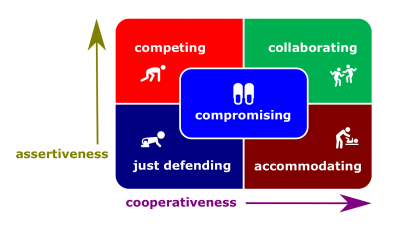Difference between revisions of "Collaborating intent"
| (One intermediate revision by the same user not shown) | |||
| Line 4: | Line 4: | ||
==Definitions== | ==Definitions== | ||
According to [[Organizational Behavior by Robbins and Judge (17th edition)]], | According to [[Organizational Behavior by Robbins and Judge (17th edition)]], | ||
| − | + | :[[Collaborating]]. A situation in which the parties to a conflict each desire to satisfy fully the concerns of all parties. | |
| + | According to [[Looking Out, Looking In by Adler, Proctor (15th edition)]], | ||
| + | :[[Collaborating]]. A conflict management style that seeks win-win solutions. | ||
==Related concepts== | ==Related concepts== | ||
| Line 12: | Line 14: | ||
*[[Social Rationale Quarter]]. | *[[Social Rationale Quarter]]. | ||
| − | [[Category: Septem Artes Administrativi]][[Category: Articles]] | + | [[Category: Septem Artes Administrativi]][[Category: Articles]][[Category: Human Communications]] |
Latest revision as of 16:21, 10 July 2020
Collaborating intent (or, simply, collaborating) is a situation in which the parties to a conflict each desire to satisfy fully the concerns of all parties.
Definitions
According to Organizational Behavior by Robbins and Judge (17th edition),
- Collaborating. A situation in which the parties to a conflict each desire to satisfy fully the concerns of all parties.
According to Looking Out, Looking In by Adler, Proctor (15th edition),
- Collaborating. A conflict management style that seeks win-win solutions.
